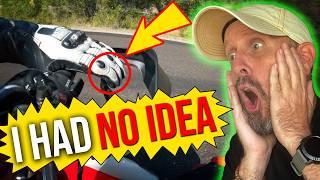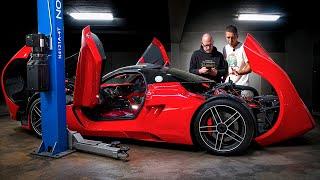
A Better Way: How To Shift a Motorcycle (For Beginners)
Комментарии:

A motorcycle in the hands of an incompetent individual is a great way for them to self delete. Would you blindly give someone access to a big lathe or a milling machine or a shed full of power wood working tools? No you wouldn't.
The presence of a clutch is a great way to keep such people away from things they shouldn't be playing with. The electronic clutches appearing on some new bikes are going to result in people hopping on bikes that they shouldn't be on

I remember about 9 or 10 years ago trying to teach my son to ride his first motorbike with a clutch and he found it hard to understand. With your knowledge and the simplicity of this video it makes it so much easier. Super video Dave. Well done, stay safe and ride well 🤓
Ответить
Question, sir. How come we learn shifting the way you teach it, but as soon as you get any experience, everyone around, you is shifting very jerky? Lightning fast twitches of the feet and hands and I don’t know every time I try that the bike jerks too. Once or twice, I’ve tried to rev match and blip the throttle and the bike just blips too.
Ответить
Release the clutch slowly till you get a feel for where it engages. Gp shift usually has a quick shifter too. Some bikes do not like going into 1st at higher speeds.
Ответить
Great video, using this video as a first watch for my son so it will make my job easier for me to teach him once we are in an open lot. Thanks again
Ответить
Nicely done. In city driving, I like to find neutral and release the clutch while at a red light. Japanese motorcycle transmissions make this EASY. My Ducati makes this HARD. How do I make it easier? Yes, I have often been that lazy guy clicking down through all gears after I have stopped. I will pay better attention to the speed match fundamental.
Ответить
The best advice I got when i rode my first bike was feel the clutch. Dont try to do the robot thing. increase the power and let out the clutch, FEEL THE CLUTCH. Great video.
Ответить
Interesting video, just one question. Why do Americans insist on saying "rpms"? You know RPM is already plural, right?
Revolutions per minute...

Great video. As a follow-up video it would be nice to develop on the idea of clutchless up and down shifting.
Ответить
I like gp shift. It more natural to shift like that on a bike, especially if you want to go fast. Counterintuitive though, as your brain sometimes in stress go like i need a lower gear so i need shift down, even afer ears of using gp shift.😅
Ответить
Why lie though, you don't need to always shift with clutch. And your little quickshifter sensor is a proof of that. ...ok, now I watched to that part, my bad 😅
Ответить
The sequential gearboxes on bikes can be a new experience even for people who are familiar with other manual-shift vehicles. This video is a great introduction to the process. If you're learning how to ride right now, then bookmark this video and come back to it as you practice. Everything Dave talked about here is useful information.
Ответить
Love the content on your channel but not a fan of the insta360 fisheye views. Sorry.
Ответить
Best explanation in the transmissions I have seen yet. Outstanding video!
Ответить
i tried teaching a guy how to drive manual in a car and he was absolutely hopeless. i don't even know how to describe how completely hopeless he was.
then he got on a bike and took to it like it was nothing. instantly. i don't know what the difference is, but somehow the motions just make sense to him on a bike, but not in a car.

don't limit yourself later by giving in to the fear now. just get the bike you want and learn how to shift. the e-clutch and the auto tranny are not fun. riding is about having fun, and half of it is how you control the bike. not having to use a clutch is taking away half of that equation. i promise you will thank yourself later if you can power through the fear now.
besides, a healthy amount of fear is a good thing. and pushing through it will feel so amazing when you're shifting like a pro after no time at all.

i'm not sure where he's getting these shifting rpm's from, but they vary greatly from one bike to another. i've never ridden a cruiser, so maybe they would be shifted at 2k, but i've never ridden a bike that would be shifted that low. if you've never heard of "lugging" an engine, i'll tell you now, it's a bad thing. it puts undue pressure on the rings. lugging the engine is when your rpm is too low for the amount of throttle you're giving it. for a cruiser, like i said, their rpm's are lower than anything else, so maybe less than 2k is fine. idk. but for any other bike, it's ok in first gear, but do not try to accelerate in second or above if the rpm is 2k or less. if you're cruising at 2k and you need to accelerate, downshift and then accelerate.
you should practice going through the gears anyway, when you're new. <<<you're not going to wear out your tranny by shifting more than necessary.>>>

All I've owned is cars with stick shifts. And I'm only middle age. And yes I'll very much inconvenience myself to find a stick shift car, even if I have to search 16 dealerships and hunt half the state online. I find the truck-suv-cuv trend dull, disconnected, boring, and ugly.
But the motorcycle clutch? pieces of cake.
Motorcycles should be something to aspire to, something above people, something that needs to be mastered, something that brings satisfaction when learned, something of a skills and coordination showcase.
If people can operate an Xbox or Playstation, don't cry to me about how a clutch is some kind of barrier to entry. Also with slip/assist clutches, the pull force is of zero consequence anymore. Might take more force to open those energy drinks.

"Stuck with" is kinda harsh.
Manual transmission is actually better. A lot more fun to drive, better economy, more control. It's just women who can't do it. That's why were "stuck with" automatic transmissions in this life.

Excellent knowledge and presentation. 👏
Ответить
Thanks for a great video, it reminds me of learning the clutch when I first started to drive in the 70's. My friend had his first motorcycle which was a Honda CL100, I think a 72' model. That was my first experience with a clutch. Later when I was getting my driver's license, Dad had an old 63' Ford Galaxie 500 with a three speed on the tree. Even later I had a 75' Kawasaki H-2 750 3 cylinder 2- stroke with the 5-speed and neutral was on the bottom of the shift pattern. All of my vehicles were clutches until I bought a 2010 Silverado which has an automatic transmission, and I still have it today. I even learned how to drive a Semi, tractor trailer with the 5-speed and the dual speed which made it a 10-speed and you definitely have to remember what gear you are in! One thing I have to say about clutches and stick shifts is that they are so much more versatile.
Ответить
When i started driving big trucks over 20 years ago, i learned how to match engine speed to road speed when downshifting before a red light so that i could "anticipate" the green light and be ready for it... so as a new rider (4 months now), it was easy for me to do the same on my motorcycle.
However, i didn't know that i couldn't hold the clutch and coast to a stop sign without also doing the "engine speed road speed matching" thing. Many times during the 1st 2-3 weeks, i would hold the clutch while in 4th gear and just coast to the stop sign. But then, i found it hard to do my 3 downshifts to get back in 1st gear and didn't know why... until now. I didn't know that it was "designed to shift better when the rear wheel is moving". Now i know... so thanks 🙂
But i did learn (by myself) to hold the clutch + do the engine - road speed matching when downshifting to a stop sign (like for a red light) and saw how everything was smooth and easy.

You have been a motorcycle instructor for over 25 years and yet you got the constant mesh gearbox all wrong? In constant mesh gearbox gears aren't sliding in any way or moving in relation to each other, hence the name CONSTANT mesh. Connection between the gears is achieved by gear dogs wich are pretty hefty pieces of metal and can really withstand a whole lot of torture. With a little bit of practice, one can safely and smoothly change gears on constant mesh transmission without using clutch. Only starting and stopping requires clutch.
Ответить
Grumpy old uncle here! Been driving a standard transmission on my everyday driver for longer than I can remember. Except for city driving limitations I’d prefer it. Way more control! I live in Iowa so winter driving comes into play.
Ответить
for new riders, make a habit of keeping the bike in gear when stationary at a stop light, doing parking lot maneuvers, etc... it is tempting to have the bike in neutral while backing out of a parking spot for example or waiting for a green light. but you may need to immediately start moving and being in neutral will take you a few extra seconds (especially when backing up a bike and you're on your left foot). i've only needed it a few times over the decades of riding but it's a good habit. (same could happen when coasting in neutral. depending on the speed, you may not be able to put it in 2nd or 1st without some effort. it is safer to always have the bike in the appropriate gear even when coasting w/ the clutch pulled in. the motif is 'be ready to get going quick is needed')
also i didn't catch it mentioned, finding yourself in an upper gear at a complete stop, you have two options to change gears: rock the bike back and forth a little or use the clutch to 'barely' engage the gears, pull the clutch in change the gear, repeat.
most times the gears will make a click as you slowly release the clutch signaling you may pull it in and change the gear.

These videos are great, enjoying them a lot man! Keep it up 🙏
Ответить
Both my 1st car and my 1st motorcycle i bought. i learned how to shift and use the clutch on the way home. car 16 year old, motorcycle @18 how else do you learn back in the 70's
Ответить
Great video for new riders who are unfamiliar with clutches. Well done Dave.
Ответить
Of this is appropriate for beginners in USA where people start on 600cc to litre we are in shit lol.
Ответить
Excellent explanation and demonstration! Thank you!!😊
Ответить
One of the major faults that learners learn from Riding Instructors is, only using the front break, or ignoring the use of the back break.
This video is a prime example, you mention when slowing down from 60mph, “. . . I’m going to roll of the throttle on to the front break, . . .”
Instructors quite correctly tell students . . . “that 70% of breaking power comes from the front break.” or “most of the breaking is from the front break.” Students often interpret that as, “I must use the front break, I must use the front break, I must use the front break …”
Then in practice, whenever they break, no matter the circumstances, they grab a handful of front break with the total exclusion of the back break, and wonder why the motorcycle disappears from underneath them.
They get up, pick up their bike and try again, this time really concentrating on the front break, (because, that is what was drummed into them by their instructor), and this time grab more of the front break and come off again.
Experienced riders know, that there are many occasions where using the front break only is dangerous, they also know that there is never a time when it is dangerous to use the back break.
Learners should be instructed in this correctly, on wet roads, the front break is dangerous, at slow speeds, the use of the front break is dangerous, cornering, the front break is dangerous.
They should be instructed to use both breaks, period. We all know that the back break hardly slows down the motorcycle, especially with heavy cruisers like Harley Davison’s, which (compared to all other motorcycles), have same day breaking at best.
Learners should be taught when breaking -
- to always use both breaks whenever possible,especially in emergency breaking
- to feather the front break when using it
- never use the front break alone, unless at a complete stop
- the back break can and should be used by its self on certain occasions.
Complete novices to riding or driving, have zero experience in breaking anything, and the messages they are getting world wide from Riding Instructors in their initial fundamental riding courses, is dangerous and Leeds to many accidents, and adds to the fear of riding motorcycles.
Even experienced riders who have been taught this way still make stupid, totally avoidable mistakes breaking, because of this, in our Club we have to teach them to unlearn the “Front break only” message they rightly or wrongly assimilated from being tough to ride, and have been using throughout their riding period, and then teach them to only use the front break while using the back break, and even then, try too use the back break only most of the time.
We ride close together in a staggered formation, which is the safest way to ride, giving each rider the maximum advantage to break and manoeuvre safely, while using the group as protection while on the road.
The fault in todays teaching, is too much emphasis is being given to front break use and none given to both break use or back break only use. Some may put forward a compelling argument for this style, but the evidence is clear that for whatever reasons, a significant number of students are interpreting the message as, “I must use the front break only.”
Experienced riders know about “trail breaking” and its uses in better cornering etc, which people learn in advanced riding courses, but it is only a small percentage of riders who attend these courses.
Constructive comments please, this is more about the way in which using the front break is being taught, rather than not using the front break.

Now..THAT......education😂😂😂
Ответить
Very clear explanations!
Ответить
Hi, thanks for the video, some say that it is not necessary to squeeze the completely in the clutch to shift, they say squeeze half (adventure bikes) is enough. What do you recommend?
Ответить
Happiness often sneaks in through a door you didn't know you left open.
Ответить
I feel like I’m in chemistry class again in high school. This guy is super sharp super smart I trust everything this man says. Completely
Ответить
Wow I knew all of this at 8 years.
Explains maybe why you talk to us as we’re 8 year olds.

Great content, although I don't get the part about 2,000 rpm = 2nd gear, 3,000 rpm = 3rd gear. I find my bike runs best between 2,000 and 3,000 rpm. So when I'm in 2nd gear and speeding up, when I'm around 3,500 rpm I'll shift up to 3rd gear and maintain the engine between 2,000 and 3,000 rpm. Same for shifting up from 3rd to 4th gear.
I always maintain the engine in that range, so the gears are related to the speed I'm going at.

EXCELLENT: the most COMPREHENSIVE explanation, I've seen.
Ответить
Hilarious
Ответить
Definitely a video every new rider should watch. Beautiful!
Ответить
clutches are easy to understand. It's a just brake with the pedal reversed. A brake normally slips until you engage it, then it clamps fixed pads to a disc to stop the disc. A clutch is just one disc on the engine and another on the transmission, normally clamped together to spin together, but slip when engaged.
Ответить
Great video man
Ответить
My bike doesn't have a tachometer lol 😢
Ответить
So in an obtuse way, heel shifters are just hillbilly gp shifters 🤔
Ответить
I’m an aspirational rider and I bailed out of my first attempt at an MSF course because the clutch was so overwhelming. Thanks so much for making this video, it really helped put so many different pieces of the clutch puzzle together.
Ответить
Very good presentation on the operation of the clutch. Let me point out one thing. Your bike has to have enough power at idle to release the clutch at idle without adding throttle. My 250 dual sport will stall every time!
Ответить







![Lubuntu 22.04 LTS Configuration - Revive an old MacBook for Multimedia Work [2/4] Lubuntu 22.04 LTS Configuration - Revive an old MacBook for Multimedia Work [2/4]](https://rtube.cc/img/upload/TUw2ZXNsY3JXODE.jpg)

















